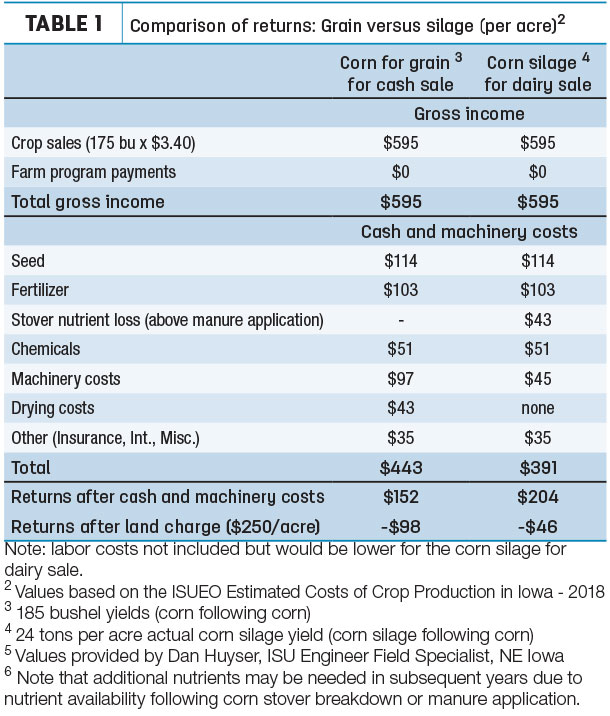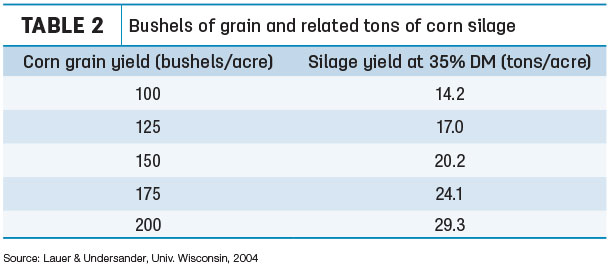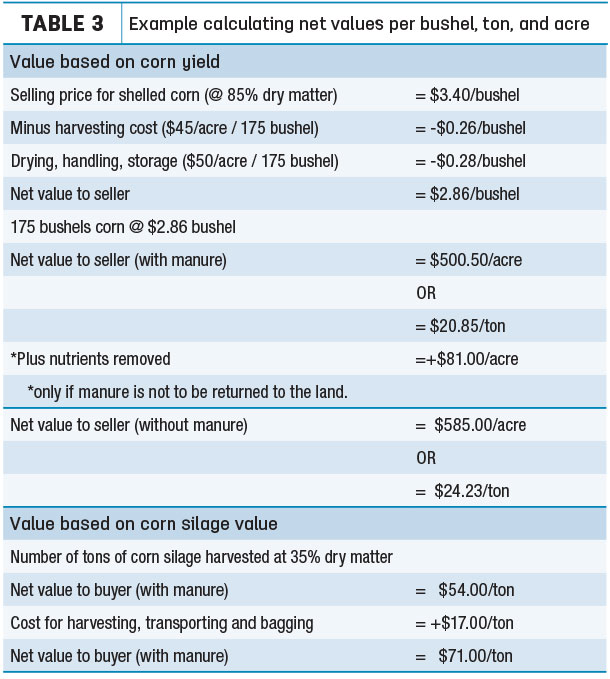The dairy industry continues to change as herd size relative to crop acres increases. This creates a need for more off-farm corn silage to be purchased and more manure to be exported off-farm.
A corn silage contract can be mutually beneficial. The buyer can benefit with the purchase of a high-volume, energy-rich feed that can be harvested and stored in a timely fashion. This feed has a value per ton of dry matter more cost-effective than other grain or forage alternatives.
It may also provide an opportunity to dispose of excess manure for dairies needing additional land for manure disposal. The seller can benefit by increasing net returns.
There are many ways to value corn silage. One option is to price the corn silage per ton standing in the field at seven to eight times the price of corn per bushel. Another option, and the one being explained here, is to sell the corn based on its grain value and exchange the non-grain biomass for the buyer’s dairy manure.
In this option, the corn silage seller benefits by attaining a local market price with less labor and without harvest, drying, transportation or storage costs. And the buyer re-applies manure at least to the value of the most limiting nutrient, usually phosphorus (P).
Table 1 shows the seller can improve profits by selling the corn as corn silage versus grain. Either way, the crop producer receives the value for the grain produced.

Thus, in Table 1 returns can be improved by $52 per acre by selling the crop as corn silage versus grain since machinery, labor and other costs are saved by not needing to harvest, transport, store or dry the corn.
An issue needing attention is the lessened amount of residue left in the field, from both a nutrient and environmental perspective. However, the use of cover crops or timely application of dairy manure bartered in the transaction could and should reduce this issue to a more negligible level.
The trading of the cornstalk biomass for dairy manure can be a win-win situation. Based on Iowa State University estimated 2017 prices, the value of the nutrients removed in the corn silage, excluding grain, is estimated at $3.36 per ton.
A thousand gallons of liquid dairy manure has 25 pounds of nitrogen (N), 12 pounds of P2O5 and 11 pounds of K2O. (Every ton of solid dairy manure contains approximately 12 pounds nitrogen, 6 pounds P2O5 and 12 pounds of K2O.) Twenty-four tons of corn silage per acre (stover and grain) removes an estimated 193 pounds of N, 84 pounds of P2O5 and 216 pounds K2O.
Application of 7,000 gallons of liquid manure per acre (14 tons of solid manure) will meet P removal rate from the corn silage. In order to replace all nutrients, additional commercial fertilizer at the rates of 18 pounds of N and 139 pounds K2O (25 pounds of N and 48 pounds of P with solid manure application) needs to be applied to meet nutrient removal. The cost of this fertilizer amount is equivalent to the cost of stover nutrient loss in Table 1.
The minimum price the seller would sell for is the value of the corn grain if brought to market. The maximum price the buyer would buy for is the value of competitive forage and grain feedstuffs. The buyer and seller should both determine a value per ton or per acre of corn silage and come to an agreement between both values.
Example
Value to the seller is based on per bushel of grain and then valued on per acre or ton of silage harvested.
If the selling price for corn is $3.40 per bushel, for example, and it takes 54 cents per bushel in harvesting, drying, handling and storage cost, the value to the seller is $2.86 per bushel. At an average of 175 bushel corn per acre, the crop is worth $501 per acre to the seller.
If re-applying manure was not part of the contract, an additional $81 per acre will be added for the value of N, P and potassium (K) removed with the stover.
As shown in Table 2, the equivalent of 175 bushels is 24 expected tons of corn silage.

Table 3 outlines the value of corn silage to the seller and buyer; an equitable or fair price can be determined by evaluating net values for both parties.

For the seller, the value per ton is $24.23 per ton in the field without manure application. The value to the buyer will also include the costs for chopping, hauling, filling and packing/bagging the corn silage.
For the same field, the buyer estimates on a per-ton basis the value of 35 percent dry matter silage based on nutrient value (i.e., value of starch, neutral detergent fiber, etc.). This value equals $54 per ton or 7.7 cents per pound of dry matter.
The buyer’s cost of chopping and hauling the corn silage is estimated at $7.35 per wet ton ($4 to $10 range) based on custom rate estimates. Another $9.50 per ton is typical for bagging costs. (Average custom rate of bagging is estimated at $11.90 per foot, assuming 10-foot bag and 1.25 ton per bagged foot.) Therefore, the total 35 percent dry matter corn silage value to the cow would be $71 ($54 + $17).
This does not include shrinkage due to fermentation and feeding losses. The buyer and seller can then negotiate the value per ton based on the difference of each determined price.
The percent dry matter is important to determine. Priced at the field, silage at 40 percent dry matter is valued at $62 (800 pounds dry matter x $0.077), and silage at 30 percent dry matter is valued at $46 (600 pounds dry matter x $0.077).
This ensures the grower will receive the same gross payment regardless if harvested at varying moisture levels. The value to the buyer will also include the cost to chop, haul, fill or pack the silage.
The per-bushel of corn harvested would require a pre-harvest yield check. If the payment is based per ton harvested, it is critical to have accurate dry matter tests and yield estimates. This will require moisture testing representative samples daily or by field.
In addition, weighing all representative loads of silage across a scale is needed or knowing the capacity of the bunker, silos or bags used. Price adjustments will be needed for corn silage at varying moisture levels.
Grain price can be taken as the local price at harvest, an average across the harvest month or average of harvest month price across contract months. Price should be agreed upon by both parties and put in writing to prevent misunderstandings. ![]()
Kristen Burke is a former Iowa State University Extension and Outreach farm management field specialist.
References omitted but are available upon request. Click here to email and editor.

-
Larry Tranel
- Extension and Outreach - Dairy Field Specialist
- Iowa State University
- Email Larry Tranel






